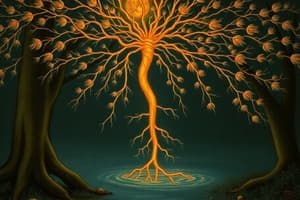Podcast
Questions and Answers
An organ is made up of the same type of tissue.
An organ is made up of the same type of tissue.
False (B)
A cell consists of protoplasm and nucleus.
A cell consists of protoplasm and nucleus.
True (A)
The watery fluid percolating through spaces among the cells is known as blood plasma.
The watery fluid percolating through spaces among the cells is known as blood plasma.
False (B)
Nutrients are absorbed by the cells from the lymph.
Nutrients are absorbed by the cells from the lymph.
The walls of cells and capillaries act as filters permeable to anything as large as a protein molecule.
The walls of cells and capillaries act as filters permeable to anything as large as a protein molecule.
If the blood flow stops, diffusion within the body continues.
If the blood flow stops, diffusion within the body continues.
The two main structures of most organs are the parenchyma and the stroma.
The two main structures of most organs are the parenchyma and the stroma.
All organs of the body are composed of five types of tissue.
All organs of the body are composed of five types of tissue.
Epithelial tissues include only the outer layer of the skin.
Epithelial tissues include only the outer layer of the skin.
Mechanical tissues are primarily made up of cells.
Mechanical tissues are primarily made up of cells.
Muscular tissues are composed of two types of highly specialized cells.
Muscular tissues are composed of two types of highly specialized cells.
Nervous tissue originates from a different layer of tissue than the outer skin in embryos.
Nervous tissue originates from a different layer of tissue than the outer skin in embryos.
Flashcards are hidden until you start studying




